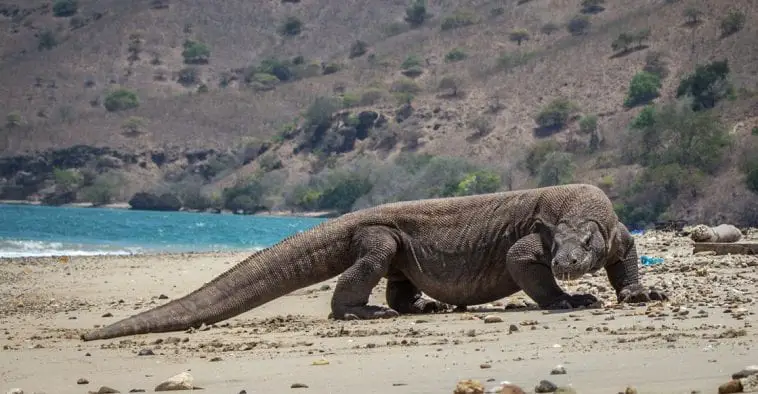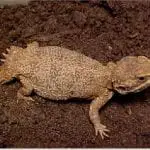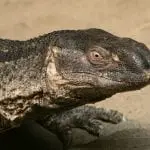The exotic pet trade is not something that should be seen too lightly. There are people out there who actually encounter a lot of risks when they are capturing exotic reptiles just so they could sell them to breeders or potential lizard owners who are willing to either keep them as pets in their own homes or in zoos where they can be used for research or for safekeeping.
After all, the risky part comes if you are factoring in the fact that different reptiles have their own unique behavior patterns and personalities. There are some that are more docile, while others tend to be ferocious and will attack when they feel threatened. Those who tend to be more on the dangerous side of things are the bigger lizards. And if we are talking about big lizards, none can get bigger than the Komodo Dragon.
Being the ones who have to capture and trap Komodo Dragons is one of the gutsiest jobs out there in the world due to how dangerous this lizard can be. The Komodo Dragon is not only big and heavy but also is quite vicious to the point that one fully grown adult can be enough to put down a few trappers. That is why those who take part in trapping these monitor lizards have some of the most difficult jobs in the world.
To get to know why it takes guts to be a Komodo Dragon trapper, let us first get to know more about this monitor lizard.
What is the Komodo Dragon?
General information
The Komodo Dragon is the largest known species of monitor lizards in the entire world. These reptiles are native to the island of Komodo in Southeast Asia and have only been discovered in 1912. Before their discovery, they were once called “land crocodiles” by natives in their native language. There is a good reason as to why they are land crocodiles because they can get just as big as crocodiles and are as ferocious as they are due to their voracious appetite.
Due to how large and dangerous the Komodo Dragon is, it is actually impractical for anyone to keep them as pets. That is why they are only kept by zoos or by different types of institutions meant to help preserve these lizards’ numbers or use them for research purposes. Those that keep Komodo Dragons provide them with large habitats that are built to be solid and sturdy enough to keep these large reptiles locked securely. Some institutions actually build pens that are about a thousand square feet big just to house these lizards.
Size and appearance
As mentioned, the Komodo Dragon is the largest known lizard in the entire world and is far bigger and heavier than any other lizard. It can be as long as about 8 to 10 feet at its full adult size. Meanwhile, there are some that could weight over 200 pounds of pure muscle. That means that they are large and in charge of lizards that can easily overpower any human or prey.
There are different Komodo Dragons with their own unique colors. This includes blue, orange, gray, and green. They have rough and thick skins that seem durable enough to handle the scratching and clawing they encounter when hunting for prey. Komodo Dragons actually look like the tanks of the lizard world due to their large and heavy build and their overall durability.
Komodo Dragos have really long claws that can easily tear apart flesh and destroy cages that are not built to be strong and sturdy enough. They also have muscular legs that allow them to run speeds of about 13 miles per hour. That means that they can easily outrun an average man, who can run speeds of about 8 miles per hour.
The mouth of a Komodo Dragon is lined with thick and sharp teeth that are built to tear apart flesh with just a single bite. And because they eat a lot of raw meat, these reptiles have mouths that are full of bacteria to the point that one single bite from these monitor lizards will be enough to put down a very large animal due to infection.
Diet

Video URL: FoxNews
Komodo Dragons are purely carnivorous eaters that will only eat meat. But, unlike other types of lizards that only eat animals that are small enough to fit their mouths, Komodo Dragons will eat anything. They will even hunt for prey that is larger than they are, such as water buffalo. Some of their normal prey include deer and pigs. They can even scavenge for carrion lying around anywhere. And when humans are careless enough to step into the hunting grounds of a Komodo Dragon, these reptiles will hunt them down and even overpower them. A normal Komodo Dragon has an appetite that is so big that it can eat up to 80% of its normal body weight in just a single feeding.
When they are hunting, Komodo Dragons have a unique way of doing things. These reptiles can spot their prey for up to about a thousand feet due to their keen eyesight. Using their strong feet, they can chase their prey rather quickly. Once they come close enough, they usually use their huge and strong feet to knock their prey down. After that, they use their shark-like teeth to tear through their prey’s flesh and to shred it until it dies. Even when the prey escapes these large reptiles, a single bite from a Komodo Dragon has enough bacteria to cause an infection so bad that it will kill the animal within 24 hours. And by using its strong sense of smell, the Komodo Dragon will hunt down its dead prey to finish what it had started.
As one of the most efficient eaters on the planet, the average Komodo Dragon only leaves behind 12% of its prey as it eats almost everything, including bones, hide, hooves, and even intestines. They are able to eat large chunks of meat and even swallow an entire animal whole because of their strong neck muscles and movable joints similar to a snake.
Temperament
Komodo Dragons are vicious predators that will see anything as a potential meal unless the animal is the size of an elephant or is a predator that is bigger than they are, such as a full-grown crocodile (although they probably do not encounter each other in the wild). They are not afraid of anything and will even prey on large buffalos because of how big and strong they are. As such, it is never advised to come near a Komodo Dragon or even be anywhere within its hunting domain as it might see you as a potential meal.
It is not possible to domesticate or tame a Komodo Dragon, given its vicious and ferocious nature as an alpha predator. Even Komodo Dragons kept in zoos are just as dangerous as their wild counterparts. However, these monitor lizards are actually quite intelligent as evidence has shown that they know how to distinguish normal humans to that of their caretakers.
Why Komodo Dragon trapping is dangerous?
· They are large
As mentioned, Komodo Dragons are extremely large monitor lizards that can easily dwarf the second-biggest monitor lizard on the list. They are bigger than the average human and can easily overpower a full-grown man using its heavy body and its strong and muscular legs.
· They can kill with a single bite
Komodo Dragons are so dangerous that they can kill a full-grown human with a single bite. Studies have shown that they have a lot of bacteria in their mouths as a result of rotting meat stuck in their teeth. As such, a single bite can cause bacterial infections that can kill any large animal within the next 24 hours if left untreated.
· They eat anything
Another thing that makes Komodo Dragon trapping dangerous is that these reptiles will eat anything. They are not afraid of humans and will most likely try to eat one if given a chance. Unlucky trappers will find themselves getting hunted instead of being the ones trapping the Komodo Dragon if the animal gets a step ahead of them.
Who are Komodo Dragon trappers?
Komodo Dragon trappers are those who trap and capture Komodo Dragons for a living. They are experts in their field and are knowledgeable of the usual behavioral and hunting patterns of these monitor lizards through extensive studies, research, and training. There are some who trap Komodo Dragons to take them back to the west to keep them in zoos, institutions, or research facilities. Meanwhile, some Komodo Dragon trappers only trap the lizards to tag microchips on them so that they are easier to monitor in their natural habitat in the wild. They are then allowed to roam freely after that.
How do Komodo Dragon trappers trap this large monitor lizard?

Video URL: YouTube
Trapping a Komodo Dragon is a very difficult endeavor, but the mechanism for trapping them is actually quite simple and primitive. While there are some more primitive ways to trap a Komodo Dragon, such as in the video above, professional trappers have their own ways of doing it.
A good way of trapping a Komodo Dragon is to use an aluminum box to serve as a cage. Meat, which is tied to a cable contraption, is often placed inside the box to serve as bait for the hungry yet unsuspecting Komodo Dragon. Once it tries to go inside the box to eat the meat, the cable is pulled, and it will shut the box’s sliding door down to keep the reptile inside the cage trapped. This is one of the safer ways to trap a Komodo Dragon without hurting it.
After trapping the Komodo Dragon, trappers usually get the lizard out by using a noose over at the entrance of the sliding door. The noose is then pulled over to the neck of the lizard, and it would then be pinned down using the noose. It will take a team to actually keep an adult Komodo Dragon down as there should be someone grabbing it by the tail and another one holding its rear legs to secure it using ropes. Meanwhile, its mouth would be taped close to make sure that it does not bite anyone.
Why not sedate the Komodo Dragons?
Komodo Dragons are naturally built to be different compared to mammals. Their own individual bodies react to sedatives in a different way. While sedatives can still put a Komodo Dragon down and keep it asleep, it might take a few hours for it to fall unconscious. The difficult part is waking it up and to keep it alive while it is sedated since the lizard can stay asleep for days while needing someone to help it breathe in that state. As such, trapping is the better option if we are talking about the Komodo Dragon’s overall safety.



